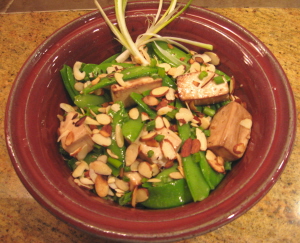
Gardeners here on the subtropical Gulf Coast are extremely well acquainted with fast-growing legumes. The most infamous is kudzu, a Japanese native plant innocently promoted in the 1930s as a means of erosion control. Farmers were paid $8 an acre to plant the twisting, woody vine in their unused fields, where it rapidly swallowed up the landscape. The plant had no natural enemies in this country and — surprise! — it thrived in heat and humidity. County extension agents, amazed and dismayed, estimated kudzu’s growth rate at 12 inches per day. Barns, vacant houses and carelessly parked pickup trucks disappeared beneath a shroud of glossy green leaves. Urban legends sprang up, detailing the terrible fate that awaited anyone who fell asleep too close to the edge of a kudzu patch.
The snow peas in our garden are distant cousins of kudzu. (Other Leguminosae include lima beans, soybeans and peanuts.) Most years, my Sugar Pod snow peas top out at their usual 3 feet in height… but this year they seem to be in hot pursuit of Cousin Kudzu’s nickname: The Vine That Ate the South. Planted in the fall, then encouraged by an unusually mild winter, they grew. And grew. And grew.
Now we’re plucking sweet, crunchy pods from a snow pea jungle just over seven feet high. We’re steaming the tender, pale green pods. We’re stir-frying them. We’re eating them raw on salads. Visitors to the house are sent home clutching complimentary bags of snow peas. Fortunately, tender snow peas and other edible pod peas freeze beautifully.
My favorite snow pea recipe in the universe is on the sketchbook page at the beginning of this post. We cooked up a batch last night, and here’s how it looked just before being devoured by two hungry gardeners:

It comes from The Moosewood Restaurant Kitchen Garden, a book that manages to combine gardening tips, wildly delicious recipes, inspiration and elegant illustrations. (Read a few pages, and then try to resist the urge to run right out and start planting seeds. I dare you.)
I always try to keep at least 1/4 of my total garden space in legumes. Here’s why: Peas and beans are good sources of protein for hungry vegetarians, and they are good sources of nitrogen for hungry garden soil. Hardworking bacteria living on the roots fix nitrogen from the air. When your harvest is over and it’s time to till up your plot in preparation for the next season’s crop, you can dig leguminous plants right into the soil while the vines are still green. They rot down rapidly, and all that stored nitrogen is released. (Legumes will also work their magic on your compost pile, if you prefer.)
Thanks for your wee visit over to my blog…
Ive never heard of snow peas before, that’s something new I’ve learned today 🙂
p.s. your artwork is beautiful
Townie
The recipe sounds delicious — I like to eat as many legumes as I can in lieu of meat. And yes, your artwork is amazing!
Thank you for the beautiful artwork and yummy recipe. I, too, grow wonderful food. I garden in Michigan: a long way from the South. I would love to take art lessons from you!
your posts, as your art, are always so inspiring!
Diane
I am growing snow peas, too…had no idea they were relatives of kudzu…your illustrations are extraordinary!
Wowee…I absolutely love your style…it’s so unique. Beautiful composition here.
Goodness me, I am in love with that illustration. Beautiful. Illustrated recipes are quite possible the best.
I just came across this post in a search for subtropical gardens on wordpress and I am quite happy that I did! I have a snow pea vine growing at the moment, it’s still a while off harvest time, but I might put this recipe aside for when I am ready!
I planted y first snowpea’s a few months ago in Sydney’s Autumn. It’s now the dead of winter (Ok, so the daily temps are just below 20, and nights 10degC), but, like you these snow peas seem to not know when to stop.
I bought two of these ornate trellises, about 4 feet tall each, and planted half a packet of peas around them. First thy grew off the top of the trellises, then grabbed on to nearby row of pencil pines… Now they are at the top of those too, reaching at the shy. They are literally too high for me to even get some of the peas off…
All I did was water them each second day and threw a little cow manure around before tilling and planting. (No other fertilizer used, just water)
w.o.w…
(Just checked again, they seem to have smothered the last old summer tomato and are now growing across our (dormant) olive tree. It’s quite a comical sight as it now covers half of my wall of pines that stretch across the whole back yard. The whole thing in planed in about 2sq feet.